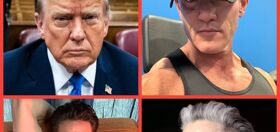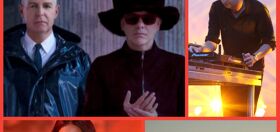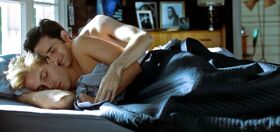On coming out
Long before he officially came out of the closet on The Joan Rivers Show in 1990, Jim J. Bullock was gay on television. With an encyclopedia of exaggerated gestures and contorted faces, he charmed his way from a one-time guest spot as naïve, overgrown, sexless man-child Monroe Ficus into a co-starring role on ABC’s fluff family sitcom Too Close For Comfort for six years in the 80s.
Though sparring internally with the Anita Bryants and Billy Grahams of his Southern Baptist childhood, Jim’s audiences never knew it. If you caught his stand-up act at the Comedy Store in the late seventies, you’d probably ask who that gay guy was — the one with the perm, lip-syncing in foam go-go boots to Nancy Sinatra. “I had energy shooting out of every hole in my body,” Bullock recalls to Queerty. “There were no limits to what I would do on stage.”
Except, of course, talk about his sexuality.
On his (drag-infused) stand-up act
It’s easy to picture the barely legal Jim J., bouncing into Los Angeles from Odessa, Texas, earmarked Bible in his carry-on, unable to shake the Baptismal waters from his head.
He was a classic case: the asexual court jester, the people pleaser who cracked the joke before anyone else could make one at his expense. “I didn’t like to rock the boat,” he says. “I didn’t perceive myself as gay, I just thought of myself as funny.” And so did the casting directors who saw Jim’s set and gave the 20 year-old his big break. (But let’s be honest: They probably did perceive him as gay.)

In a case of art imitating life, the TV network execs, Too Close For Comfort‘s producers, and Jim simply ignored the visible gayness of his character, Monroe, for as long as they could. During the first two seasons, writers handed Monroe a pair of romantic interests: a transvestite who he believes is a biological female, and an elderly woman who takes his virginity (played by Selma Diamond). And lest we forget the infamous episode where Monroe is tied-up and raped (yes, raped) by two heavyset biker chicks in their van in a mall parking lot. No joke. There’s even a website and short film devoted to the episode.
By season three, though, the viewing public grew savvy. Twenty-three year-old Bullock, who appeared on the show from 1980 until its end in 1986, was summoned into a closed-door meeting with producers. “We are receiving letters from viewers,” he was informed gravely. “They want to know if your character is gay. We don’t want him to be gay.”
How he was told to “act” on the show, and his character’s girlfriends
Jim wasn’t pushing to make his character gay, either.
“It was a time,” Jim says, “when people just didn’t talk about that shit; it just was not talked about.” When homosexuality was talked about in the 1980s, it was all hellfire and brimstone. Pat Buchanan, the Reagan White House communications director at the time, declared HIV/AIDS nature’s “awful retribution” on the “poor homosexuals.” A 1986 Supreme Court decision upheld a Georgia law criminalizing oral and anal sex in private between consenting adults. HIV/AIDS was decimating the gay male community and all gays were at the core of the blame game. If there was ever a decade to stay in the closet, the 1980s might have been a good time to rearrange the hangers.
I ask if that period was isolating. “It’s just the way it was. I was afraid I would lose everything if I was found out.”
While Jim lived in fear of being outed, he made no effort to play butch on camera. After all, his inherent queerness is what got him the work in the first place. But he did try to control his public image. He and his manager “worked hard” to fabricate stories for the tabloids about Jim’s love life.

“I had several girlfriends who were willing to…play beards for me,” he stammers sheepishly, “and we would do stories—plant stories—in the tabloids.” One such friend, Elaine Hill, agreed to pose as Jim’s girlfriend for a National Enquirer piece. “They took pictures of us doing domestic things,” Jim giggles, “Cooking, petting cats, and snuggling. The caption was something like: ‘We are so in love, so happy that God brought us together.'”
When Comfort ended in 1986, Jim was offered a chance to follow in the dainty footsteps of other closeted camp queens like Charles Nelson Reilly and Paul Lynde on TV’s home for out of work entertainers, Hollywood Squares. “I thought this is a place where I can just be me. I’ve been called fag all my life so I decided, okay, if you’re gonna sit there and call me fag, fine, I’m a fag.” And though he was still publicly in the closet, with no quirky character to hide behind, Jim was his most unabashed queer self. But his gayness did not go unnoticed by the powers that be.
Whoever thought of pairing Jim J. Bullock and Tammy Faye Bakker in 1996 as co-hosts of a daytime talk show deserves a GLAAD award, a LAMBDA award, and a Kennedy Center Honors. They were absolutely precious, like two Kewpie Dolls with googly eyes and impish dispositions. As their show theme song (which they sang together) described, they were “not what you’d expect…a crazy, goofy duet.” The emotive televangelist and the now-publicly out Bullock both grew up in devoutly religious conservative Christian households. This, in Jim’s opinion, is what bonded them.
On working with Tammy Faye
“We had such an understanding of each other,” he says. “We were two very similar people with two very different paths but held onto a lot of what we both once had.” And both Tammy and Jim encountered struggles with their faith along the way.
Even years after the show ended, Evangelicals criticized Tammy for co-hosting The Jim J. and Tammy Faye Show with a gay man — especially when Jim came out as HIV-positive. His status was half-outed, really. In preparation for the 1997 AIDS ride, Jim sent a sponsorship letter to possible donors. He mentioned that in addition to riding in memory of his deceased partner, he was riding for his friends living with HIV/AIDS and that he, too, was living with the disease. A few days later Jim was awakened by knocking at his door.
It was a tabloid reporter inquiring about his HIV status.

The Jim J. & Tammy Faye Show. The rhyming title, alone, is indicative of what is possibly the queerest daytime talk show in the herstory of the world. Even the set was gay: stark white minimalist with colored blocks and repetitive Warhol portraits of Jim and Tammy. The show was at least 10 years ahead of its time and probably would have thrived on a network like LOGO. In syndicated daytime television, however, it only lasted one season. As per usual, the Suits fucked things up. “They kept coming up to us going, ‘Tammy, don’t talk about Jesus, don’t cry.’ ‘Jim, you’re being too gay. Don’t talk about that.’ And it was like, you hired the queen of religious TV and the biggest queen that we know of on TV and now you’re telling them they can’t be what they are?” It was a scene that had played itself out on every other show of Jim’s almost twenty year career. He was crossing the gay line again.
His bond with Tammy: Having similar faiths
“It’s funny,” Jim says forlornly. “After a decade of fear, covering up, hiding, and coming into the nineties and seeing something like a Will & Grace come along and going, ‘God Dammit, God Dammit.’ I would have loved to have been on a hit sitcom playing gay, being gay. How wonderful is that?”
I point out that when it comes down to it, he was gay on TV. Audiences knew he was gay and he had visibility. “I was gay on TV, yes. And I was not afraid to be myself regardless of what battles were going on inside of me.” That is the hallmark of Jim J. Bullock.
Jim J. is a humble man. He claims he’s not a flag-waving activist. “I’m not a boat-rocker,” he repeats. He keeps using 1950s civil rights references to describe his position in the 80s: “You just didn’t drink from that water fountain. You had your own water fountain.” And, “You sat where you sat on the bus.” Jim seems to have, at the time, accepted his status as a second-class citizen.

“I just didn’t want to hurt my family.” Were they upset?, I ask. “Oh yeah, oh yeah. It’s still not…” He doesn’t finish the thought. “My mother is 91 and has no idea her son is a gay icon. And I don’t throw that gay icon thing around, like, ‘Oh, I’m a gay icon.’ But I do know that when people look back on 80’s television thinking gay, I’m probably one of the top five who pops up in their heads.”
Who else comes to mind?, I challenge.
He can’t think of anyone other than George Michael and one guy from The Kids in the Hall. I can’t think of anyone, either.

Gay life ain’t no place for sissies. But it should be. The Unabashed Queer (Government Name: Matt Siegel) serves to affirm the vast array of queer identities. Originally from Atlanta, Siegel realized his independence above the Mason-Dixon Line at Northfield Mount Hermon School and subsequently, Sarah Lawrence College. In a marijuana- induced haze, Siegel came to Los Angeles and has found himself employed in the homes of Adam Carolla, Arianna Huffington, and Jill Clayburgh. How queer is that? Read Matt’s blog here.
Relive Jim’s television history on the following pages.
How about we take this to the next level?
Our newsletter is like a refreshing cocktail (or mocktail) of LGBTQ+ entertainment and pop culture, served up with a side of eye-candy.




















Jaroslaw
Not to take anything away from Jim Bullock, but Paul Lynde was pretty Gay acting on Hollywood Squares, Liberace too. And there are others, but that would not exactly make Jim the first and/or definition of “Gay” on TV would it?
merkin
I understand not coming out in Hollywood in the 1970s, and I even understand taking a minstrel role like Munroe–but to give him kudos for it?! Ive met Jim, and he’s an nice guy. But it must be a frickin’ slow news day to run a seven-page story on the guy
Marius
One of the other guys who was sitting in a square with Bullock – Charles Nelson Reilly. Kinda gay.
Is Bullock the only one to have come out? I don’t know.
Sean “Jack” Hayes hasn’t, but I know that’s none of my business.
Not So Fast Cowboy
wow,
“Too close for Comfort” ran for _six_ years?
koalaboy
You guys on here always piss me off with you’re ridiculous comments on what things the moderators should use their time reporting on.. why don’t you make your own site and write about what you want!
I’m a young gay comedian and found this article very resourceful and entertaining. Thank you 🙂
David Ehrenstein
Very nice interview. Jim J. is a lovely man and a very talented comic actor. It’s so odd to think of all the silliness (there’s no other word for it) that went on back then. It was obvious to anyone watching “Too Close For Comfort” that Jim J. was gay — and they loved him. Beyond sad that he was literally punished for being so talented.
Geoff M
I always knew about Jim J, and I was a little kid. I had the biggest crush on him, and still do! Thanks Queerty!!!
MackMike
Jim J.’s career began where Paul Lynde’s career ended, and while Lynde’s popularity soared during the sexual revolution that unfolded in the 1960’s and eary 1970’s, Jim J.’s was launched in a suprisingly oppressive era. The scourge of AIDs set back the GLBT community is ways that are probably incomprehensible to many who did not live through it. All gay men were viewed as disease carrying deviants, who God was specifically punishing. Stories of community pools being drained if a gay man thought to have HIV were featured on Oprah and Donahue, and gays who worked in restaurants, dental offices, in the medical profession were either fired, or exposed to rentless discrimination. Patrons even demanded that gay waiters be fired from restaurants who depended upon their dollars. Children with HIV, like Ryan White, were dismissed from their schools.
This all unfoladed, even after a great deal of information swelled to counter the public fears–education seemed to simply fall on deaf ears. The Moral Majority was in full swing, and gays who had just begun to enjoy maintstream acceptance found themselves being forced back into a closet. Thanks to the courageous efforts of activists, such as Larry Kramer, a resistence built in the GLBT community, but in many ways our community is still recovering.
This was the environment that Jim J. was faced with as he portrayed Monroe. Where as Lynde’s Uncle Arthur was laughed with, with a nudge and a wink; the social attitudes at the time created such an environment of intollerance that viewers were only willing to laugh at the most outrageous, the bitchiest and the most fey characterizations of gays at the time. The character of Monroe was none of these, yet still perceived as being possibly gay, and this more realistic portrayal of a “gay” man was very threatening to audiences.
Though not a fan of the show, I did watch from time to time as a kid, and even I could see that Bullock was walking a high beam in a difficult to maintain balancing act. Nevertheless, the one thing that should be pointed out is that Lynde, who had the benefit of a friendlier culture in his time, was reportedly not a very kind human being. Having had the pleasure to spend a long afternoon with Jim J. at a wedding reception, I can first hand report that he is in person what he has always appeared to be on camera, a very gracious and warm man, with an engaging sense of humor and great knack for timing.
Jim J. deserves all seven pages that have been dedicated to him here, I assure you.
Dabq
Thanks for one of the best articles I have ever read on this site, and, all the best to Jim J. Bullock who was indeed a gay trailblazer!
J-Like
It’s a great article. I remember this show, vaguely, and I think the only reason I watched was Monroe. I was a kid, I could somehow sense something about this Monroe guy, it was the kind of thing where you wait for that fleeting echo of something that seems familiar to you and yet you don’t understand. We can now talk about minstrelsy and all those things, but we really can’t adopt a holier-than-thou attitude about it: we don’t know what those times were really like. We roll our eyes when we read a book from the early twentieth century advocating a woman’s right to stand up to her husband, thinking that she really should divorce him and set up her own business and get a “room of her own.” But these people did not live in our current world. Were there people who bucked the trend, who seem more courageous to us now b/c they were uncompromising? Sure. But those who do the high wire act, trying to be in the mainstream and also to be true to themselves, they deserve our respect, not our condescension. I had forgotten about Jim J and Too Close for Comfort until today. I’m glad I remember him now: I liked seeing him, brought me back a sense of childhood and of being different even before I could name it. I also think that b/c the show was set in SF, I began to develop an association between SF and queers—and here I am! Thank you Jim J!
Monstro The Whale
I don’t think ever played Monroe as gay — he played him as a SPAZ. And it was funny. His effiminate qualities were thrown in ofcourse – but people watching in Too Close For Comfort’s heyday were more astounded by his energy and clowny spazzy character.
I was called ‘Monroe’ by a few close fahhag in highschool. Go figure. ‘Gay’ was still the thing that dare not speak its name in suburbia circa 1982.
I also really liked the TCFC’s army camoflage and head-band wearing dyke-prototype character of APRIL played by Deena Freeman. She rocked hard.
lifeofthecity
@merkin:
slow news, fast news day…you’ll still be as cynical i bet….you’re such a twat
Cam
I remember how offputting it was to me, how gay Monroe was on the show, and then they tried to have him have a girlfriend later, I was very little and didn’t quite get why the character bugged me. I had a similar feeling when Anthony on Designing Women had a series of Vegas/stripper girlfriends….it’s like. Yeeeeaaahhhhhh, Riiiiiiiight.
BobP
What about Nancy Culp as Miss Hathaway on the Beverly Hillbillies? We can’t leave her out.
Sarah
I was a kid and I knew Monroe was gay…and Monroe helped shaped my sense of humor. Thank God for that.
marius
@BobP:
Even the Hillbillies writers gave Miss Hathaway a crush on Jethro.
That was believable. I’d take Cousin Bessie over him.
Joanaroo
Thank you for this article. I liked Jim J. and watched T.C.F.C. It’s a shame he had to work thru the homophobia of the 80s. Technology was being developed, yet attitudes about gays went back to the Salem witch hunt days. Glad to see Jim J. again.
Mike
Great article! A perfect change from some of the other crap that is posted on this blog.
nina
Great article- substantive and uplifting as well. Thanks
hephaestion
That clip with the Captain & Tennille on Jim & Tammy Faye’s show had me crying. I had no idea Toni Tennille was a big friend of the gays. It was very moving.
mikebuc
Thanks for the memories. Absolutely love Jim J. Always envied his hair in the 80’s!
Marius
Too Close for Comfort was on the air at pretty much the same time as Three’s Company. Monroe vs. Jack Tripper…something, anything there?
Brian JC Kneeland
I remember Jm J Bullock – on the Ted Knight show.
Jeffrey Thomas
And before Jim J Bullock there was Paul Lynde
Douglas Schlitz
Thank God we have progressed since the dark times of the 80s and Reagan.
Lots of progress to be made yet.
Ruth Winkler
Its Jm. No “i” in the middle.